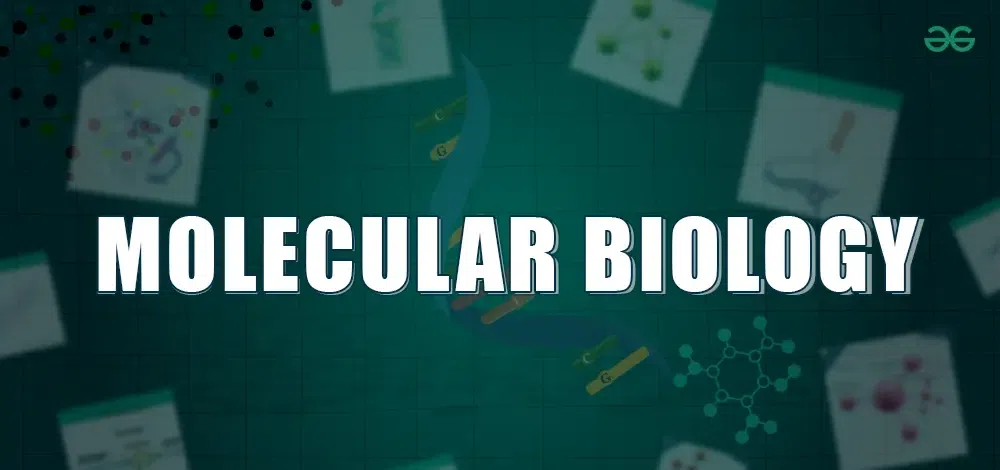Molecular Biology - Basic Concepts
Last Updated : 09 Jan, 2024
Molecular Biology is the key to solving the working of the biological processes in our body. The term "Molecular Biology" refers to the 'molecular' part of the biological world. Starting from cells, right up to organ systems, all biological entities are studied under molecular biology. In this article, we will study what molecular biology is, Important topics in molecular biology, The role of a molecular biologist, different molecular biology techniques, and careers in molecular biology.

What is Molecular Biology?
Molecular biology is the study of the molecules of living beings. The chemical processes within a body are responsible for the functioning of an organism. The 'central dogma of biology' governs the body's process which includes replication, transcription, and translation. Molecular biology is related to the building blocks of these processes which are DNA, RNA and proteins. The main aim of molecular biology is to study the three-dimensional structures of biomolecules. Techniques such as electron microscopy and X-ray diffraction are employed to get a detailed model of their structures.
Important Topics in Molecular Biology
The main important topics in Molecular Biology are:
What does a Molecular Biologist do?
A molecular biologist is a person who does research in laboratories on various biological procedures. Molecular biologists target the molecular mechanisms that underlie various biological functions, such as gene expression, replication, and cellular signalling. Other techniques that are used by molecular biologists are Polymerase Chain Reaction, DNA sequencing, gel electrophoresis, crystallography and other imaging techniques.
Molecular Biology Techniques
To be able to study and understand the structures of biomolecules, one must know all the molecular biology techniques available. Let us delve deep into some of the main techniques that are used which are:
Polymerase Chain Reaction
The aim of the PCR is to help in the amplification of DNA, producing multiple copies of the same DNA. It is mainly used in DNA cloning. There are three main steps for the PCR - Denaturation, Annealing and Extension. PCR was developed by Kary Mullis in 1980's.
Also Read: PCR Full Form
DNA Sequencing
The genomes of various organisms are filled with vast information. The gene of an organism is made up of DNA and nucleotide sequences. The arrangement of DNA sequences can be detected via DNA sequencing. Some techniques employed in DNA sequencing are Sanger's Method and Nextgen Sequencing.
Nucleic-acid Hybridization
Nucleic acid hybridization is a molecular diagnostic technique that is used to detect the presence or absence of a specific nucleic acid sequence in a sample. It works by binding two complementary single-stranded nucleic acids, such as DNA or RNA, together to form a double-stranded hybrid molecule. This process is facilitated by the complementary base pairing between the two nucleic acids, where adenine (A) pairs with thymine (T) and guanine (G) pairs with cytosine (C).
Also Read: Difference Between DNA and RNA
Proteomics
Proteomics is the study of proteins, including their structure, function, and interactions within an organism. Molecular diagnosis using proteomics involves analyzing proteins to diagnose diseases and conditions. This can be done through various techniques, including 2-D gel electrophoresis, mass spectrometry, and antibody-based assays.
RT-PCR
RT-PCR stands for reverse transcription- PCR. In this, the RNA undergoes reverse transcription to form cDNA or the complementary DNA. This technique is very useful in studying RNA pathogens, RNA viruses and gene expression. The following image shows its major steps:
DNA Cloning
In this technique, multiple copies of a DNA sequence are created. A person can create a specific target DNA sequence that needs to be expressed in a body. The target DNA is inserted into a vector that acts as a carrier. The vector is then inserted into the host body where it produces multiple copies of that particular DNA. These vectors can self-replicate and can easily integrate with the host.
Also Read: Cloning Vectors
Microarray Analysis
Microarray analysis is a molecular diagnostic technique that uses DNA microarrays, also known as gene chips, to analyze a person’s genetic information. This method allows for the simultaneous detection and analysis of thousands of genes in a single sample. The DNA sample is labelled with a fluorescent marker and then hybridized into the microarray. The microarray contains millions of tiny DNA spots, each representing a specific gene.
Also Read: Molecular Diagnosis
Careers in Molecular Biology
After studying molecular biology, one can opt for the following careers:
- Research Scientist
- Biotechnologist
- Clinical Researcher
- Genetic Counselor
- Pharmaceutical Scientist
- Bioinformatician
- University professor
- Medical Laboratory Scientist
- Scientific Writer
Also Read,